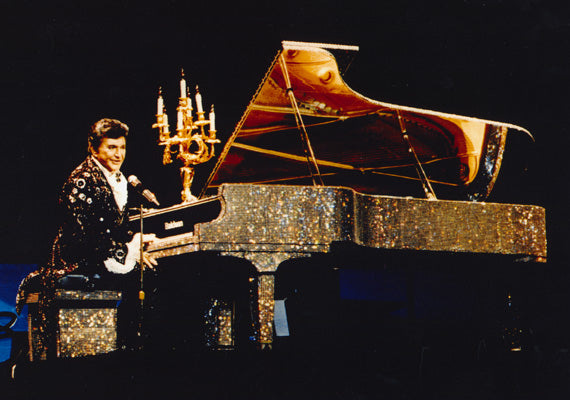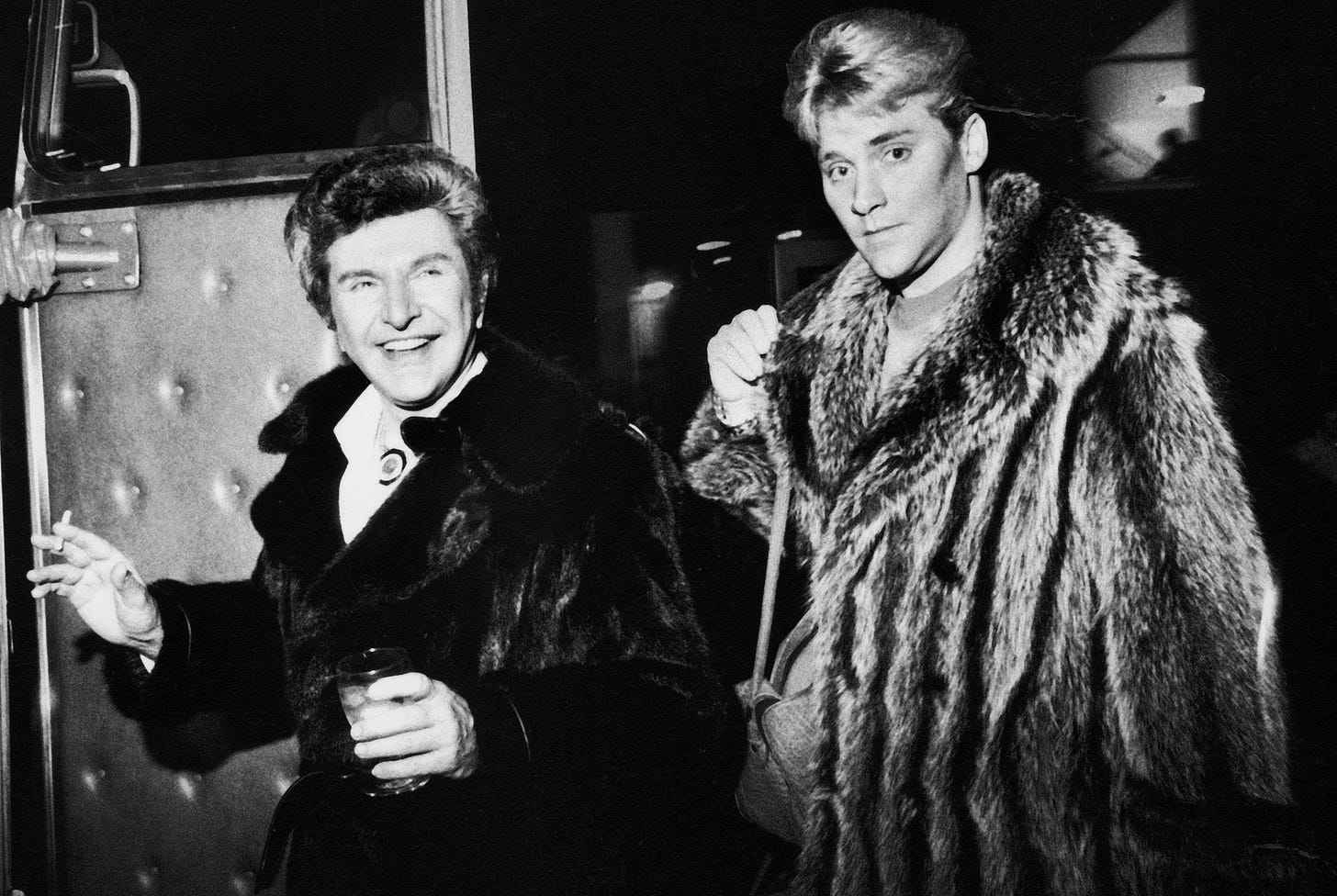If sequins could talk, they’d probably beg for mercy after a night on stage with Liberace. Here was a man who took the art of showmanship, dipped it in rhinestones, polished it with ego, and baked it under the blinding heat of an endless stage spotlight. There’s a lot to be said for performance, for delighting an audience and cultivating charm, but Liberace’s existence wasn’t just a show—it was a neon-lit parade of excess, where no crystal went unpolished and no fur coat unbought. And in Liberace’s mind, there was nothing gaudy about it. He called it “taste.”
Władziu Valentino Liberace, born to a Polish mother and an Italian father in West Allis, Wisconsin, probably didn’t come out of the womb wearing a ruffled tuxedo, but you wouldn’t be blamed for assuming he did. Growing up, he was a prodigious pianist, a talent he could have turned toward a refined career in classical music or perhaps a symphony orchestra. But subtlety was never in Liberace’s lexicon. Why settle for a modest recital hall when you could build yourself a chandelier-festooned empire of gleaming pianos and white mink capes? He found that being a virtuoso pianist was nice, but being a spectacle was infinitely better.
What Liberace understood—and most of his contemporaries didn’t—is that virtuosity alone bores the masses. People don’t pay to watch a man in tails tickle the ivories for an hour unless he does it while wearing a $300,000 bejeweled cape and exiting the stage on a rhinestone-covered rhinoceros. He turned classical music into vaudeville, and vaudeville into Vegas. And yet, beneath the gilded layers, there was real skill. Liberace could play. He just didn’t think playing well was enough. He thought it needed feathers.
If Cauby Peixoto and Clóvis Bornay had an American cousin, it would have been Liberace. The same delirious flair for theatricality, the same unapologetic embrace of artifice, the same philosophy that if it doesn’t glitter, is it even worth wearing? Like Cauby, he understood that music was as much about persona as it was about sound. Like Bornay, he knew that costume wasn’t an accessory—it was the statement. Liberace took their school of thought and dialed it up to a level that could make even the most extravagant carnival parade seem restrained. There’s a kind of genius in that—a devotion to exaggeration so profound it becomes a belief system.
What Liberace achieved was the total obliteration of understatement. From his clothing to his sets to his mannerisms, everything was dialed up past ten, beyond eleven, and all the way to Liberace—a level of gaudiness we now use as a measurement for anything excessive. But make no mistake, behind the mountain of glitz, Liberace was no fool. He understood the power of image and deployed it like a weapon, establishing himself as a caricature of luxury that America couldn’t help but consume. In a world where stars wanted to be taken seriously, Liberace wanted to be taken at face value, which, in his case, was face value plus about five thousand Swarovski crystals.
It’s tempting to laugh at Liberace—to see him as a campy relic of a bygone era. But laughter was part of the act. He was in on the joke. He told it nightly with a wink and a flourish. His performances were an exercise in overindulgence, designed to be more spectacle than music. His pianos were encrusted in rhinestones, his costumes were heavier than his dignity, and his entrances? Oh, his entrances! He didn’t just walk on stage; he arrived. Sometimes it was in a Rolls-Royce, other times on a literal mirrored staircase, the kind of grandiosity that could make a Vegas magician blush.
He understood show business better than most: don’t give people what they need, give them what they never knew they wanted. And if you can give it to them with a candelabrum balanced on a grand piano, even better. Liberace was kitsch incarnate, wrapped in ostrich feathers, winking at the absurdity of it all while making millions.
Of course, Liberace’s personal life was as sparkly and opaque as his costumes. For years, he maintained an impossibly straight public image, complete with lawsuits against those who suggested otherwise. It was a case study in irony: a man who embodied flamboyance sued anyone who dared to hint at what his persona so clearly communicated. His flamboyant persona was both an embrace and a rejection, a paradox wrapped in velvet and dripping with diamonds. In a world that couldn’t yet handle the truth, Liberace kept his life an open secret, the obviousness of which was lost on no one but denied by everyone.
His denial of his sexuality wasn’t merely personal—it was theatrical. He made heterosexuality a part of the act, another layer of costume. He flirted with female fans onstage with the same exaggerated gestures he used to stroke the keys. It was all performance. The tragedy, however, was not just that he hid; it’s that he had to. There’s no telling what kind of icon Liberace might have been had he been able to come out. Would it have mattered? Or was the illusion itself the point?
And yet, the tragedy of Liberace wasn’t in his denial of self; it was in his denial of taste. In his world, if it could be bought, it should be, and if it could be bought in gold, all the better. He collected pianos like normal people collect refrigerator magnets. His home was a pastiche of pseudo-European opulence, with Louis XV-inspired decor as filtered through the imagination of someone who’d never been to Europe but had visited Caesar’s Palace. It was a museum of excess, curated by a man who was both artist and impresario, who saw the world as a blank canvas upon which to project his wildest, most glittering fantasies.
He had taste, but it was weaponised. Liberace didn’t lack sophistication—he rejected it. He chose maximalism as a creed. His legacy isn’t that he didn’t know better; it’s that he did and chose rhinestones anyway. He was Versailles meets Vegas, powdered wigs meets polyester. An aesthetic contradiction too dazzling to dismiss.
But it wasn’t enough to simply be rich and outrageous; Liberace needed to be loved. He pandered shamelessly to his fans, cultivating an image of a man who was both approachable and impossible to touch. He called himself “Mr. Showmanship” and lived up to it in every sense, showering audiences with a warmth that was equal parts sincerity and salesmanship. For all his absurdity, he genuinely adored his audience, and they adored him back. There was something uniquely American about Liberace’s appeal—he was the promise of limitless consumption, the fantasy that anything could be yours if you bedazzled it enough.
He understood that in postwar America, showmanship was substance. The country was giddy with its own wealth, and Liberace became its bejeweled avatar. He turned conspicuous consumption into religion and his own figure into a chapel. And America, ever faithful, attended the sermon. He told people they could have it all—and if they couldn’t, they could at least watch him pretend to.
Even in death, Liberace remained on-brand—dramatic, controversial, and the subject of feverish speculation. He passed away in 1987 from complications related to AIDS, a truth that, much like his sexuality, was initially shrouded in denial. Even as tabloids hinted and former lovers spoke out, there were still those who preferred to believe he had simply perished from "watermelon diet complications," as some of his more delusional associates suggested. It was a reminder of how tightly Liberace had controlled his image—so tightly that even his mortality had to be staged.
His story would later inspire Behind the Candelabra, a biopic that refused to sugarcoat his eccentricities, exposing the darker undercurrents beneath the sparkle. The film revealed a man whose love life was as operatic as his stage persona, including relationships that blurred the line between devotion and possession. His obsession with youth and beauty manifested in his most bizarre demand—that his much younger lover, Scott Thorson, undergo plastic surgery to look more like him. It was vanity taken to its most deranged extreme, the ultimate act of narcissism wrapped in a gilded robe.
And yet, for all his bizarre demands and pathological curation of image, there was something fragile in Liberace’s extravagance. The fur, the gold, the jewels—none of it masked the loneliness that always seemed to hover just behind his smile. Underneath the showmanship was a man who knew how to make people clap, but perhaps not how to make them stay. That, more than any of his capes, was the heaviest thing he wore.
When Liberace died, he left behind a legacy that defied categorisation. He was neither great musician nor grand actor, not quite a pop star nor a comedian, but he was Liberace. He existed in a world of his own making, a world where taste and restraint were strangers at the door. In a career spanning decades, he managed to personify an era of kitsch that lives on, a gilded statue to the idea that there’s no such thing as too much.
In the end, Liberace wasn’t simply a musician or an entertainer—he was a walking, singing, piano-playing empire of absurdity. He was his own genre, a testament to the American idea that success is whatever you can convince people to pay for. And for years, people paid. They paid in tickets, in attention, in admiration of the man who wore luxury as though it were his birthright and lived as though every day were an opening night.
Liberace might not have had the grace of a ballet dancer, the subtlety of a jazz musician, or the restraint of a classicist, but he had something far more compelling: the audacity to be too much and the charisma to make “too much” seem like just enough.
And in a world still trying to define “enough,” that might just be the boldest legacy of all.









